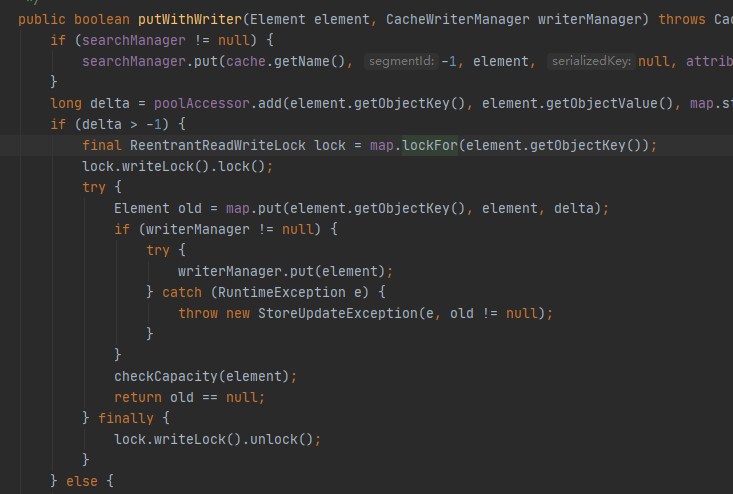最近在做业务逻辑重构,pc、app等有类似的逻辑都写在了web层,导致新增各端保持一致的需求需要更改各自站点,增加了开发成本和维护成本,所以需要把通用逻辑抽离到业务逻辑层,web层通过rpc调用实现解耦。
问题现象
抽离出来的服务上线两周必现调用方超时,服务内部逻辑处理时间急剧增加,等待处理的请求等待时间急剧增加。如下图

正常处理时间在100ms左右。查看日志,只能看到框架组件报待处理的请求等待超时。

因为报的时间点是早高峰,又有大量客户反馈,情急之下立即重启机器,只留一台机器用于验证。
服务4台机器,重启三台后,耗时下降,抓取留下那台的线程堆栈,内存dump未发现异常信息。查看当时的调用量,确实有增长,但不是很多,考虑到服务内部调用了一个很耗时的外部接口,又没有分析到问题,增加了几台机器增加下服务整体的处理能力。
但是这件事由于没有找到具体原因,像是扎在胸口的一根刺,每天早高峰的时候都盯着屏幕,观察服务状态,随时准备见状不好立即重启。
就这样过了两周后,发现服务异常复现,由于一直盯着,立即抓取其中一台的内存dump,别的机器同时进行重启,等把这台机器的dump下载下来后,对这台也进行了重启。重启后服务正常,没有客诉,于是安下心来分析dump。
用Jvisual查看堆内存看不出什么问题,于是通过Jvisual通过dump得出的线程堆栈发现成堆的BLOCKED

可以看到是获取缓存时ehcache内部锁等待。【ehcache版本1.6.2】那么为什么大家都在等呢,我们进去看MemoryStore 148行。

这个方法被synchronized修饰表示调用该对象方法的所有调用方都需要竞争该锁。【我们都知道使用被它修饰的方法在多线程下效率很低,此时我就想看看是否ehcache的高版本优化了这部分】那么我们put的时候有几个调用方呢。看Cache 1306行

这段代码的逻辑就是从磁盘中读出数据,不为空、未过期就放回内存,memoryStore是Cache中的属性,他俩是一对一的。那么Cache有几个呢,用过ehcache大家就知道了每个cache对应配置文件中的一个cache,也就是说一个name一个cache。

巧了,我的服务里面大部分都用了longCache,那么put那块锁竞争就很激烈。
看了代码之后我们就清楚原因了
由于内存中存储的数据超过设置的maxElementsInMemory,且配置了overflowToDisk,则新增的数据会存储到磁盘,看BLOCK处都出现在从内存中获取不到数据在磁盘中获取到了,获取到之后再放到磁盘中。这就导致获取缓存和缓存数据都会竞争同一个锁。
DEMO复现
import net.sf.ehcache.Cache;
import net.sf.ehcache.CacheManager;
import net.sf.ehcache.Element;
import java.io.InputStream;
import java.util.concurrent.ArrayBlockingQueue;
import java.util.concurrent.ConcurrentHashMap;
import java.util.concurrent.Executor;
import java.util.concurrent.ThreadPoolExecutor;
import java.util.concurrent.TimeUnit;
public class TestEHCache1 {
private static CacheManager cm = null;
private static ConcurrentHashMap<String, Cache> cacheTable = new ConcurrentHashMap<String, Cache>();
public static void init() {
final InputStream resourceAsStream = TestEHCache1.class.getClassLoader().getResourceAsStream("ehcache1.xml");
cm = new CacheManager(resourceAsStream);
String[] names = cm.getCacheNames();
for (String s : names) {
System.out.println("put:" + s);
cacheTable.put(s.toLowerCase(), cm.getCache(s));
}
}
private static Cache getCache(String cacheName) {
return ((Cache) cacheTable.get(cacheName.toLowerCase()));
}
public static Object getCacheValue(String cacheName, String key) {
try {
Element element = getCache(cacheName).get(key);
if (element != null) {
return element.getObjectValue();
}
} catch (Exception e) {
e.printStackTrace();
}
return null;
}
public static void setCacheValue(String cacheName, String key, Object value) {
try {
Element element = new Element(key, value);
getCache(cacheName).put(element);
} catch (Exception e) {
e.printStackTrace();
}
}
public static void main(String[] args) {
init();
setCacheValue("longCache", "test1", "value1");
final Object cacheValue = getCacheValue("longCache", "test1");
System.out.println(cacheValue);
//给jvisual连接时间,获取线程dump
try {
Thread.sleep(5000L);
} catch (InterruptedException e) {
e.printStackTrace();
}
Executor executor = new ThreadPoolExecutor(100, 320, 1000L, TimeUnit.MILLISECONDS, new ArrayBlockingQueue<Runnable>(5000));
for (int i = 0; i < 100000; i++) {
int finalI = i;
try {
executor.execute(() -> {
long begin = System.currentTimeMillis();
setCacheValue("longCache", "test_INFODO_DAFASDFAFEWFEWF" + finalI, "value" + finalI);
System.out.println("put cost:" + (System.currentTimeMillis() - begin));
});
} catch (Exception e) {
e.printStackTrace();
}
}
for (int i = 0; i < 100000; i++) {
int finalI = i;
try {
executor.execute(() -> {
long beginTime = System.currentTimeMillis();
final Object longCache = getCacheValue("longCache", "test_INFODO_DAFASDFAFEWFEWF" + finalI);
System.out.println(longCache + " cost:" + (System.currentTimeMillis() - beginTime));
});
} catch (Exception e) {
e.printStackTrace();
}
}
}
}
ehcache1.x配置
<?xml version="1.0" encoding="UTF-8"?>
<ehcache maxBytesLocalHeap="1K" maxBytesLocalOffHeap="0M" maxBytesLocalDisk="1M">
<diskStore path=""/>
<cache name="longCache"
<!--调成1,使得数据立刻存入磁盘-->
maxElementsInMemory="1"
eternal="false"
timeToIdleSeconds="10"
timeToLiveSeconds="10"
overflowToDisk="true"
diskPersistent="true"
diskSpoolBufferSizeMB="200"
diskExpiryThreadIntervalSeconds="120"
memoryStoreEvictionPolicy="LRU"
/>
</ehcache>
打印耗时

可以看到耗时在400ms左右
查看线程dump,问题复现。

修复方案
服务在此处缓存是为了降低对第三方调用,缓存到内存中的缓存数目后对第三方服务的压力没有很大,没必要再落到磁盘,且服务也不必须启动时从磁盘中读取缓存数据,所以把overflowToDisk设置为false可以解决。但是方法的同步效率不高,在查看高版本代码后,发现它优化了这部分代码【下图】,测试后在大量数据存取效率明显高于1.x版本。

由于3.x版本改动量较大,调用方式,配置文件都有很大差别,不是向下兼容的,最后比较下使用了2.x版本相对改动较小。且我们知道同一个cache名字下的数据使用同一锁,新版本的话粒度相对于1.x粒度变得很小,但是不同业务使用同一个cache也存在效率上的问题。
最后改动方案
ehcache升级到2.10.6
新增cache用于该业务
ehcache最终配置如下
<?xml version="1.0" encoding="UTF-8"?>
<ehcache xmlns:xsi="http://www.w3.org/2001/XMLSchema-instance"
xsi:noNamespaceSchemaLocation="ehcache.xsd" updateCheck="true"
maxBytesLocalHeap = "800M"
dynamicConfig="true">
<sizeOfPolicy maxDepth="100000" maxDepthExceededBehavior="abort" />
<diskStore path="java.io.tmpdir"/>
<defaultCache
eternal="false"
timeToIdleSeconds="180"
timeToLiveSeconds="180"
overflowToDisk="false"
diskPersistent="false"
diskSpoolBufferSizeMB="50"
diskExpiryThreadIntervalSeconds="120"
memoryStoreEvictionPolicy="LRU"
/>
<cache name="longCache"
eternal="false"
timeToIdleSeconds="3600"
timeToLiveSeconds="3600"
overflowToDisk="false"
diskPersistent="false"
diskSpoolBufferSizeMB="200"
diskExpiryThreadIntervalSeconds="120"
memoryStoreEvictionPolicy="LRU"
/>
<cache name="bizXXCache"
eternal="false"
timeToIdleSeconds="1800"
timeToLiveSeconds="1800"
overflowToDisk="false"
diskPersistent="false"
diskSpoolBufferSizeMB="200"
diskExpiryThreadIntervalSeconds="120"
memoryStoreEvictionPolicy="LRU"
/>
<cache name="shortCache"
eternal="false"
overflowToDisk="false"
timeToIdleSeconds="300"
timeToLiveSeconds="300"
diskPersistent="false"
diskSpoolBufferSizeMB="200"
diskExpiryThreadIntervalSeconds="120"
memoryStoreEvictionPolicy="LFU"
/>
<cache name="maxCache"
eternal="false"
timeToIdleSeconds="86400"
timeToLiveSeconds="86400"
overflowToDisk="false"
diskPersistent="false"
diskSpoolBufferSizeMB="100"
diskExpiryThreadIntervalSeconds="120"
memoryStoreEvictionPolicy="LRU"
/>
</ehcache>
上线后已平稳运行20多天,问题解决。
后记
其实在第一次出问题时,我们如果获取当时的线程dump就能够分析出问题,但是在报警和客诉的压力下,快速重启恢复导致问题再次出现,也告诉我们如果一个没有找到问题的问题还会再次出现问题。
